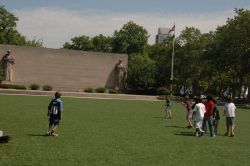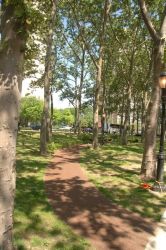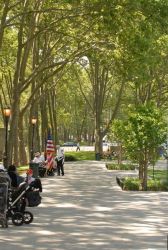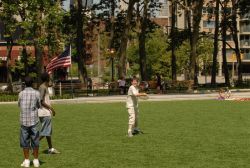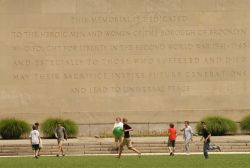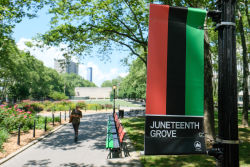Cadman Plaza Park
Cadman Plaza Park
What was here before?
Prior to European settlement, Brooklyn Heights was a Lenape village named Ihpetonga, meaning “high sandy hills.” In the 19th century the area was populated with rowhouses as well as industrial facilities, and the opening of the Brooklyn Bridge in 1883 spurred transit access and further development. In addition to many buildings, the Sands Street Terminal and elevated rail-lines previously occupied portions of the land comprising Cadman Plaza.
How did this site become a park?
In the early 1930s, preceding the construction of a new automobile ramp to the Brooklyn Bridge, the parcel was slated to house a large auditorium. The bulk of the ten square-block property from the bridge ramp to Borough Hall was condemned in 1935 and named Cadman Plaza in 1939.
By 1936 much of the site was cleared by the late 1930s, WPA laborers had built an interim park of open fields and shade trees. Mayor LaGuardia revived plans for a downtown Brooklyn civic center dating to the outset of World War I. The Fulton Street El train was demolished in 1941, and in 1943 the Brooklyn Bridge terminal at Sands Street was razed—described by the Brooklyn Eagle as “slaying the Black Spider.”
The Brooklyn War Memorial, honoring Brooklynites who served in World War II, stands in the park’s northern section. Designed by the architectural firm of Eggers and Higgins, it features monumental statues by Charles Keck (1875-1951) symbolizing Victory and Family, and was completed in 1951. A new park plan, designed by Clarke and Rapuano, provided a mix of open plazas framed by rows of London Plane trees whose tapered alignment created a “forced perspective” of visual distance.
A bronze bust and relief sculpture by A. A. Weinman (1870-1952) honoring reform mayor William Gaynor (1849-1913), was placed at the northern end in 1926. and pre-dates the park.
In 1987 the southern plaza by Borough Hall (old Brough Hall Park) was renamed Columbus Park and renovated in 1994, with a recreated historical cast-iron fountain, ornamental garden, and improved pedestrian path between Fulton and Montague Streets. The triangular portion of Cadman Plaza south of Tillary Street was renamed Korean War Veterans Plaza in 1992 and a wall of honor installed along the northern entryway.
The upper park has been renovated on several occasions, including the introduction of a synthetic turf athletic field adjacent to the war memorial. In 2020 the Tillary Street entrance path was designated “Juneteenth Grove” with 19 flowering trees planted and banners and painted benches bearing the colors of the Pan-African flag. Renovation of the northern oval lawn and paths, and Gaynor plaza was completed in 2024.
Who is this park named for?
This park honors Reverend Dr. Samuel Parkes Cadman (1864-1936), a Brooklyn Congregational minister and radio preacher famed for his oratory. He was pastor of the Central Congregational Church in Brooklyn for 36 years and helped found the Federated Council of Churches in America, which he headed from 1924 to1928.
Reverend Cadman was considered to be the Congregational faith’s leading minister not only in the United States but worldwide. He spent his summers preaching in Europe, and every Good Friday for over 30 years he delivered a sermon at the John Street Methodist Church in Manhattan. A dedicated minister to the end, Reverend Cadman collapsed while giving a sermon in Plattsburgh, New York and died one week later.
Check out your park's Vital Signs
Clean & Safe
Green & Resilient
Empowered & Engaged Users
Share your feedback or learn more about how this park is part of a
Vital Park System


